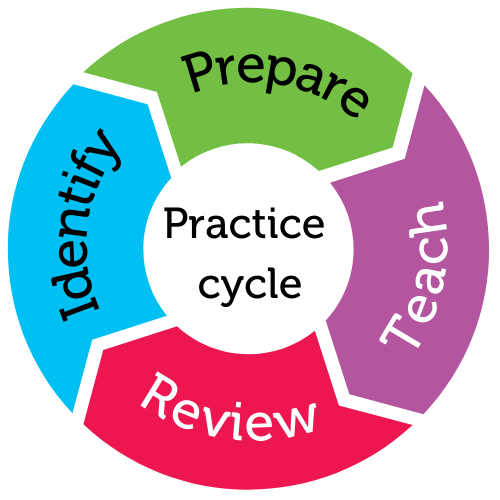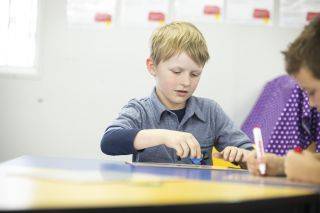
For student year
Helps students to
- solve social problems
- become independent
Helps teachers to
- support students
- model strategies
Summary
Social problem solving is a skill that develops during the early years of school. It is the process and strategies used to analyse, understand, and respond to everyday problems, decision making, and conflicts.
Social problem solving is often fostered intuitively through interactions with others. Some students, including those on the autism spectrum, may benefit from systematic instruction in helpful strategies for social problem solving.
Social problems can be as simple as turn-taking, and as complex as bullying.
Instruction helps students to understand:
- what a social problem is
- how to recognise a social problem
- the process to follow when a social problem occurs, and
- the strategies they could use to solve a social problem.
How the practice works
Watch this video to learn more about this practice.
Duration: 03:49
Australian Professional Standards for Teachers related to this practice
1.6 - strategies to support the full participation of students with disability
4.1 - support student participation
4.2 - manage classroom activities
4.3 - manage challenging behaviour
For further information, see Australian Professional Standards for Teachers AITSL page
Preparing to teach
Be proactive
- Identify barriers to learning and social demands and put these strategies in place to reduce the likelihood of problems occurring in the first place.
- Use observations to develop a clear and comprehensive understanding of the problem(s) that the student is experiencing.
- When necessary, seek external specialist assessment and opinion. You can then:
- understand possible triggers
- be alert to any potentially challenging situations throughout the day.
- Identify the specific strategy to teach students how to find a solution. There are several strategies available in the Resources section below.
- Plan to explicitly and systematically teach the social problem solving process to students:
- as a whole class
- in small groups
- individually
- a mix of above.
Use supports
- Identify and develop the visual supports required to explicitly and systematically teach a social problem solving process and keep these handy. These can be social stories, routine charts, or emotion cards for self-regulation.
- Identify appropriate storybooks and visual supports that you can incorporate in your explicit teaching to enhance student understanding.
- Incorporate engaging and motivating activities, such as:
- role-play/rehearsal
- puppet play (check the students aren’t frightened of puppets)
- social stories
- visual prompts.
Consider
How will you:
- embed problem solving scenarios
- model the problem solving process
- positively encourage, support, and reinforce students to use the process to solve real-life social problems
- share the social problem solving process with families.
Communicate
Communicating with families will encourage generalisation of the associated strategy at home. You can also communicate the types of language used so families can use similar language at home if they like.
The turtle technique
When you have a clear understanding of the problem the student is experiencing, you can then identify and use a specific intervention process to teach the student how to find a solution. One such process is the turtle technique. This involves teaching students the steps of how to control feelings and calm down (i.e., think like a turtle).
You will find further templates in the resource section of this practice.
It works better if:
- the social problem solving strategy has a small number of set steps
- teachers model these steps
- students are encouraged to use to the strategy to solve their social problems whenever they occur
- language is used consistently and modelled throughout the day and at home
- visual supports are used to enhance student understanding of the strategy.
It doesn’t work if:
- the student is expected to solve a social problem when distressed or overloaded
- the student hasn’t understood the problem solving strategy (so it will need re-teaching)
- the problem solving strategy has too many steps.
In the classroom
Step 1: Teach social problem solving
Explicitly and systematically teach a social problem solving strategy using visual supports. These are available in the resources section.
Example
You notice student A becomes frustrated when they others don't want to play the same game. You can introduce the concept of turn-taking, and establish strategies for students to determine whose turn it is, promoting fairness and equality. Student A can then independently use these strategies when this comes up again.
Step 2: Practice relaxation
Ensure that class practises relaxation skills.
Step 3: Embed and respond
Be alert to any situations throughout the day that may result in social difficulties.
Model using the strategy to solve social problems.
Support student use of the strategy in relation to their encountered social problems:
- remain calm – personally model the skills involved
- reduce ‘talk’ and use visual cues
- deal with social difficulties in a consistent manner.
Acknowledge and positively reinforce all attempts by student to use problem-solving skills.
Step 4: Review
Wait until the student is calm and receptive before providing feedback.
Step 5: Reflect
Reflect on whether the student was able to solve the social problem independently, or whether the strategy needs to be adjusted.
Record student outcomes in order to track progress.
Note program outcomes.
Practice toolkit
Practice implementation planner template
We know it's not always easy to keep track of what's working and what isn't. So, we've created this template for you to record and reflect on what you're doing to create more inclusive classrooms. The implementation planner contains:
- guidance around goal setting
- a reflection section (what worked, didn’t work, what to change, and next steps)
- prompting questions.
Implementation planner with examples
Set your professional learning goal for:
Teach social problem solving
Benefits of goal setting
Setting, working towards, and reflecting on goals helps you grow professionally and improve your practice. You can access AITSL learning resources for teachers to learn more about:How to set goals
The Australian Institute for Teaching and School Leadership recommends using the SMART matrix to frame your goal setting.SMART goals refers to goals that are:
- Specific
- Measurable
- Achievable
- Relevant
- Time-phased
Resources
Teach social problem solving - Practice Brief
Turtle Technique – 4 step problem solving process
Suri Spider Social Story - by NCPMI
Example visual support - How to choose
Example visual support: Playing 'round the world
Example visual support: Playing handball
Related Practices

Model positive interactions
TEACHING PRACTICE
For student years
Helps students to
- build social-awareness
- interact with others
This practice is from the core research project
Learning Cycle

